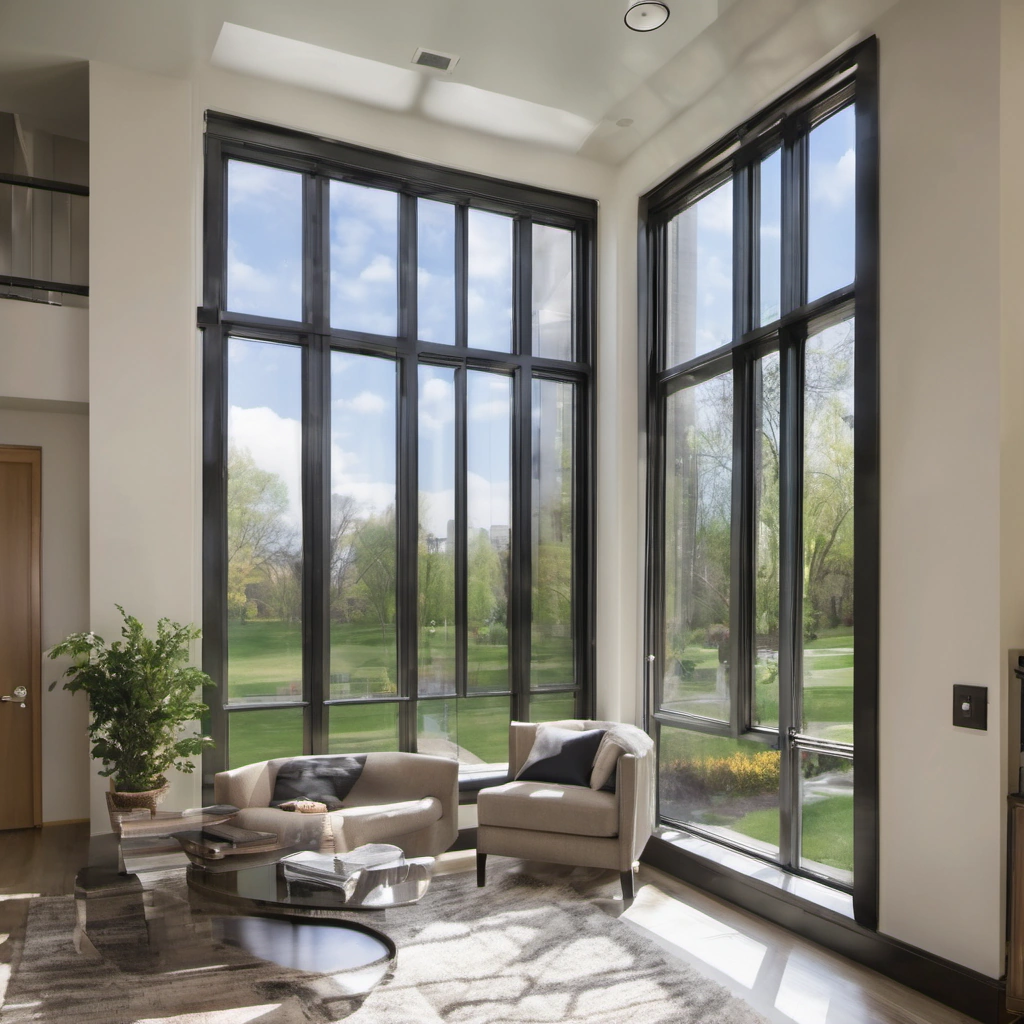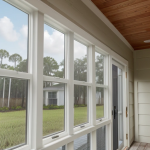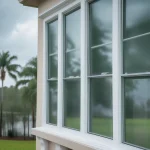Optimizing Home Energy Efficiency in Chicago: A 2025 Guide to High-Performance Window Technologies
Chicago’s Climate Challenge: Why Energy-Efficient Windows Matter
Chicago, a city celebrated for its architectural heritage and dynamic culture, also grapples with a demanding climate. From sweltering summers pushing air conditioning systems to their limits to bitterly cold winters that relentlessly leach heat, the Windy City presents unique challenges for homeowners. As we approach 2025, prioritizing home energy efficiency is no longer a mere trend but a financial and environmental imperative. Investing in energy-efficient windows in Chicago represents a strategic upgrade for any property, directly impacting comfort, utility bills, and long-term value.
This guide delves into the world of high-performance window technologies, providing Chicago homeowners with the essential knowledge to make informed decisions. We’ll explore how advancements like triple-pane windows, low-E coatings, and argon gas fill windows are revolutionizing home insulation and significantly reducing energy consumption. Understanding performance metrics such as U-factor and SHGC is crucial for selecting the optimal windows for Chicago’s climate. Furthermore, we’ll examine the aesthetic considerations and material choices, including the durability and energy performance of fiberglass windows versus vinyl windows, ensuring a balance between style and sustainability.
Beyond the immediate benefits of lower energy bills, upgrading to energy-efficient windows in Chicago contributes to a more sustainable urban environment. By reducing reliance on fossil fuels for heating and cooling, homeowners actively participate in mitigating climate change. Moreover, the increased comfort and reduced noise pollution associated with high-performance windows enhance the overall quality of life. Considering the availability of window rebates in Illinois and the potential for increased property value, window replacement in Chicago becomes an increasingly attractive and responsible home improvement decision.
Decoding Window Technologies: Triple-Pane Glass, Low-E Coatings, and More
The secret to achieving optimal home energy efficiency in Chicago lies in a deep understanding of high-performance window technologies. Several interconnected factors dictate a window’s ability to effectively insulate against Chicago’s harsh climate and regulate interior temperature. When considering window replacement Chicago, homeowners should prioritize windows designed to minimize heat transfer and maximize energy savings. Triple-pane windows, for instance, represent a significant upgrade, incorporating three layers of glass separated by insulating air or gas-filled spaces, dramatically reducing conductive heat loss compared to single or double-pane alternatives.
These windows are particularly effective in mitigating the extreme temperature swings characteristic of the Chicago climate, making them a worthwhile investment for long-term comfort and reduced energy bills. Low-E coatings are another critical component of energy-efficient windows Chicago. These microscopically thin, virtually invisible layers of metallic or metal oxide are applied to one or more glass surfaces to selectively reflect or absorb radiant heat. By minimizing the amount of solar heat entering the home in the summer and reducing heat loss during the winter, low-E coatings significantly improve overall energy performance.
Different types of low-E coatings are available, each optimized for specific climate conditions and performance goals. In Chicago, a coating designed to reduce solar heat gain is particularly beneficial for minimizing cooling costs during the hot summer months. Understanding the specific properties of different low-E coatings is crucial for selecting the right windows for your home. Furthermore, the gas fills used between the panes of glass play a vital role in enhancing insulation. Argon gas fill windows, and in some high-performance models, krypton, are commonly used due to their low thermal conductivity.
These inert, non-toxic gases create a more resistant barrier to heat transfer than air alone, further improving the window’s U-factor, a key metric for measuring insulation performance. It’s important to note that the effectiveness of gas fills can diminish over time if the window seals are compromised, highlighting the importance of proper window installation Chicago. Selecting windows with robust seals and ensuring professional installation are essential for maintaining long-term energy efficiency. Finally, the framing material significantly impacts a window’s overall energy performance.
Fiberglass windows and vinyl windows offer superior insulation compared to traditional aluminum frames, which are highly conductive and can contribute to significant heat loss. Fiberglass frames are known for their strength, durability, and resistance to expansion and contraction, making them an excellent choice for Chicago’s fluctuating temperatures. Vinyl windows, on the other hand, are a cost-effective and low-maintenance option that provides good insulation. When considering window replacement Chicago, carefully evaluate the thermal properties of the frame material to ensure optimal energy efficiency. Exploring window rebates Illinois can also help offset the initial investment in these high-performance windows, making home energy efficiency more accessible for Chicago homeowners.
Performance Metrics: U-Factor, SHGC, VT, and Air Leakage Explained
To accurately assess window performance, it’s essential to understand the relevant metrics. U-factor measures the rate of heat transfer through a window; lower numbers indicate better insulation. SHGC (Solar Heat Gain Coefficient) measures the fraction of solar radiation admitted through a window; lower numbers are desirable in Chicago to reduce summer heat gain. VT (Visible Transmittance) measures the amount of visible light that passes through a window; higher numbers are preferred to maximize natural light.
Air leakage, measured in cubic feet per minute per square foot of window area, indicates how much air infiltrates through the window; lower numbers are crucial to prevent drafts and energy loss. For Chicago’s climate, prioritize windows with low U-factors and SHGC values to minimize heating and cooling costs, while ensuring adequate VT for natural light. Understanding these metrics is paramount when considering window replacement Chicago, especially given the city’s demanding climate. For example, energy-efficient windows Chicago with low U-factors are critical for maintaining comfortable indoor temperatures during the frigid winters, directly impacting heating bills.
Conversely, a low SHGC is vital for mitigating excessive solar heat gain during the sweltering summers, reducing the strain on air conditioning systems. High-performance windows effectively balance these factors, contributing significantly to home energy efficiency and overall comfort. Homeowners should carefully evaluate these metrics alongside factors like window rebates Illinois to make informed decisions. Beyond the core metrics, additional factors influence window performance and sustainability. The type of frame material, such as fiberglass windows or vinyl windows, impacts insulation and durability.
Argon gas fill windows, often used in conjunction with low-E coatings, further enhance insulation by reducing heat transfer between the panes of glass. Triple-pane windows offer superior insulation compared to double-pane options, making them a worthwhile investment for Chicago homeowners seeking optimal energy efficiency. Furthermore, proper window installation Chicago is crucial to prevent air leaks and ensure that the window performs as intended. Selecting windows with appropriate specifications and ensuring professional installation are key to maximizing energy savings and long-term value.
In the context of Chicago real estate, investing in energy-efficient windows is not only a smart financial decision but also a selling point. Homes equipped with high-performance windows are more attractive to potential buyers who value sustainability and lower utility bills. By prioritizing low U-factor and SHGC ratings, homeowners can significantly reduce their carbon footprint and contribute to a more sustainable Chicago. Moreover, the availability of window rebates Illinois makes energy-efficient upgrades more accessible, further incentivizing homeowners to invest in their property’s long-term value and environmental impact. Integrating these considerations into home improvement projects aligns with the growing demand for sustainable living and enhances the appeal of Chicago properties.
Leading Window Brands and Models in Chicago: A Performance and Aesthetics Comparison
The Chicago market presents a diverse selection of window brands and models, each catering to specific needs and priorities. Leading manufacturers like Pella, Andersen, and Marvin offer a spectrum of options, balancing performance, aesthetics, and budget considerations. Pella’s Architect Series, for example, stands out for its high-end customization and advanced features like optional triple-pane windows with argon gas fill, crucial for combating the Chicago climate. Andersen’s 400 Series remains a popular choice, offering a reliable blend of performance and affordability, particularly for homeowners seeking efficient window replacement in Chicago without breaking the bank.
Marvin’s Signature Ultimate line is renowned for its exceptional durability and superior energy efficiency, often incorporating advanced low-E coatings to minimize heat transfer. When evaluating these options, remember that the best choice depends on individual circumstances, including architectural style, budget constraints, and long-term energy savings goals. Beyond brand recognition, a discerning homeowner should delve into the specifics of each window’s performance metrics. Look for windows certified by the National Fenestration Rating Council (NFRC) to ensure accurate and reliable data on U-factor, SHGC, and VT.
A lower U-factor signifies better insulation, vital for maintaining comfortable indoor temperatures during Chicago’s harsh winters. Similarly, a lower SHGC is preferable to minimize solar heat gain during the summer months, reducing air conditioning costs. Consider exploring fiberglass windows, such as Pella’s Impervia series or Marvin’s Elevate series (fiberglass exterior, wood interior), known for their exceptional durability and resistance to warping, cracking, and rotting, common issues in Chicago’s fluctuating climate. Vinyl windows are also a popular, cost-effective option, offering good energy efficiency and low maintenance.
Expert commentary suggests that investing in high-performance windows is a smart move for Chicago homeowners seeking to improve home energy efficiency and increase property value. According to a recent study by the American Council for an Energy-Efficient Economy (ACEEE), upgrading to energy-efficient windows Chicago can reduce energy bills by 10-25%, depending on the existing windows and the specific climate zone. Furthermore, several window rebates Illinois are available to help offset the upfront costs of window replacement Chicago, making the investment even more attractive. Consulting with a qualified window installation Chicago contractor is crucial to ensure proper installation and maximize the benefits of your new energy-efficient windows.
Installation Best Practices: Maximizing Energy Efficiency and Preventing Leaks
Even the most advanced window technologies will underperform if not installed correctly. Proper installation is crucial for maximizing energy efficiency and preventing air and water leaks, especially given the extremes of the Chicago climate. Ensure that the window frame is properly sealed to the opening, using high-quality caulk and weatherstripping specifically designed for exterior applications and temperature fluctuations. Insulate the space between the window frame and the wall with expanding foam or fiberglass insulation, paying close attention to avoid over-expansion with foam, which can warp the frame.
Follow the manufacturer’s installation instructions carefully, and consider hiring a certified installer specializing in energy-efficient windows Chicago to ensure a professional job that meets local building codes and energy efficiency standards. Pay close attention to flashing details to prevent water infiltration, a common issue in Chicago homes exposed to heavy rain and snow; proper flashing is non-negotiable for long-term performance. Beyond the basics, consider the specific needs of your Chicago home. For instance, older homes may require specialized window installation Chicago techniques to accommodate uneven openings or historical architectural details.
When dealing with brick or masonry construction, ensure that the window frame is properly integrated with the existing structure to prevent moisture damage and air leaks. Furthermore, the choice of sealant and flashing materials should be compatible with both the window frame material (vinyl windows, fiberglass windows, etc.) and the surrounding wall. A professional installer can assess these factors and recommend the appropriate solutions. Regular inspections and maintenance are also critical for maximizing the lifespan and performance of your energy-efficient windows Chicago.
Check for any signs of damage or deterioration, such as cracks in the caulk or weatherstripping, condensation between the panes of glass in triple-pane windows or argon gas fill windows, or drafts around the window frame. Address these issues promptly to prevent further damage and maintain optimal energy efficiency. Simple tasks like cleaning the windows regularly and resealing any gaps or cracks can significantly extend the life of your high-performance windows and ensure they continue to contribute to home energy efficiency for years to come. Ignoring maintenance can negate the benefits of even the best U-factor and SHGC ratings, leading to higher energy bills and reduced comfort.
Rebates, Incentives, and ROI: Making Energy-Efficient Windows Affordable
Investing in energy-efficient windows can represent a notable upfront investment for Chicago homeowners, yet a comprehensive understanding of available rebates, incentives, and tax credits can significantly alleviate the financial burden. The Illinois Home Performance with ENERGY STAR program stands as a valuable resource, offering incentives specifically designed to encourage comprehensive home energy efficiency upgrades, including window replacement Chicago. Complementing this, federal tax credits frequently extend to energy-efficient home improvements, further reducing the net cost. Savvy homeowners should also proactively investigate potential rebates and incentives offered by their local utility companies, as these can vary and provide additional savings.
Consulting with a financial advisor familiar with green incentives can also unlock less obvious opportunities. Beyond immediate financial assistance, it’s crucial to evaluate the long-term return on investment (ROI) associated with high-performance windows. The sustained reduction in heating and cooling costs, a direct consequence of improved insulation and thermal performance, constitutes a significant economic benefit over the lifespan of the windows. Moreover, installing energy-efficient windows Chicago can demonstrably increase a home’s market value, making it a more attractive prospect for potential buyers in the competitive Chicago real estate market.
The enhanced comfort derived from consistent indoor temperatures and reduced drafts further contributes to the overall ROI, creating a more pleasant and livable environment. Considering factors like U-factor and SHGC when selecting triple-pane windows, low-E coatings, and argon gas fill windows is essential for maximizing these long-term benefits. To ensure optimal results and avoid costly mistakes, engaging a qualified and certified energy auditor is a highly recommended step. A professional energy audit provides a detailed assessment of a home’s current energy performance, pinpointing areas where energy loss is most prevalent.
This assessment informs the selection of the most cost-effective upgrades, tailored to the specific needs of the home and the Chicago climate. For instance, a home facing south might benefit more from windows with a lower SHGC to minimize solar heat gain, while a home exposed to strong winds might prioritize windows with exceptionally low air leakage. Furthermore, proper window installation Chicago is paramount to realizing the full potential of energy-efficient windows; even the highest-quality fiberglass windows or vinyl windows will underperform if not correctly installed and sealed. Exploring window rebates Illinois and understanding the nuances of home energy efficiency are vital steps toward a more sustainable and valuable home.


